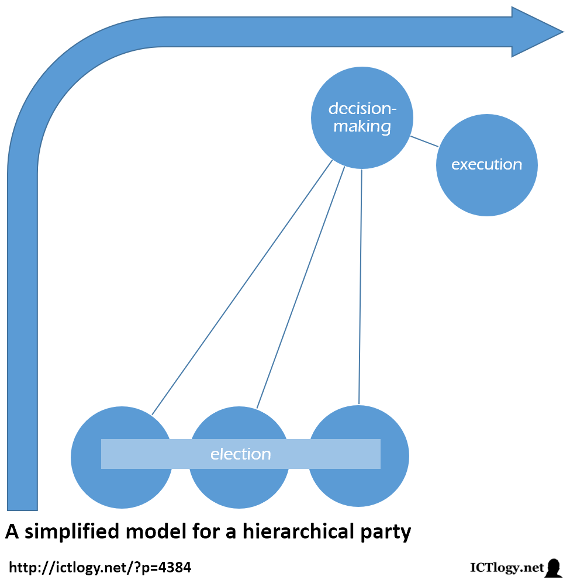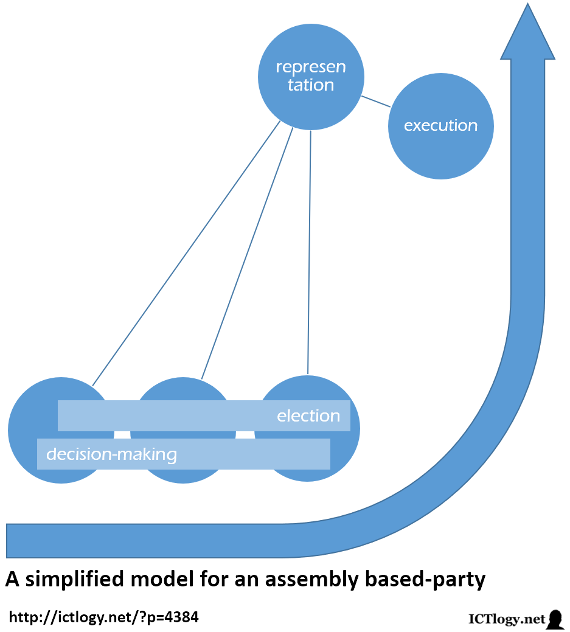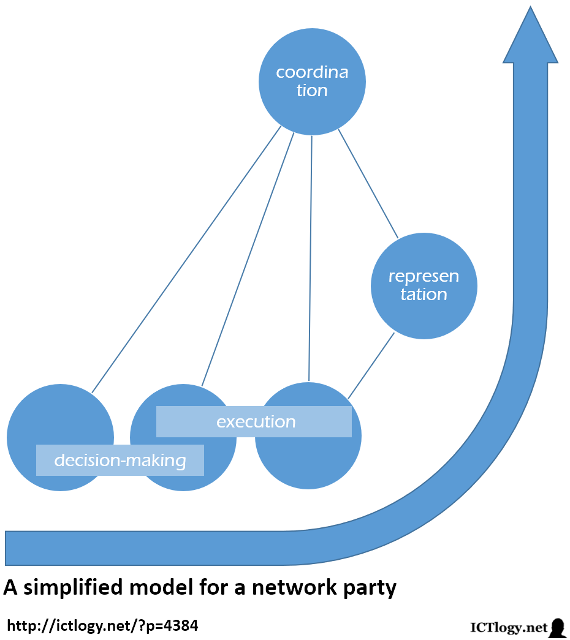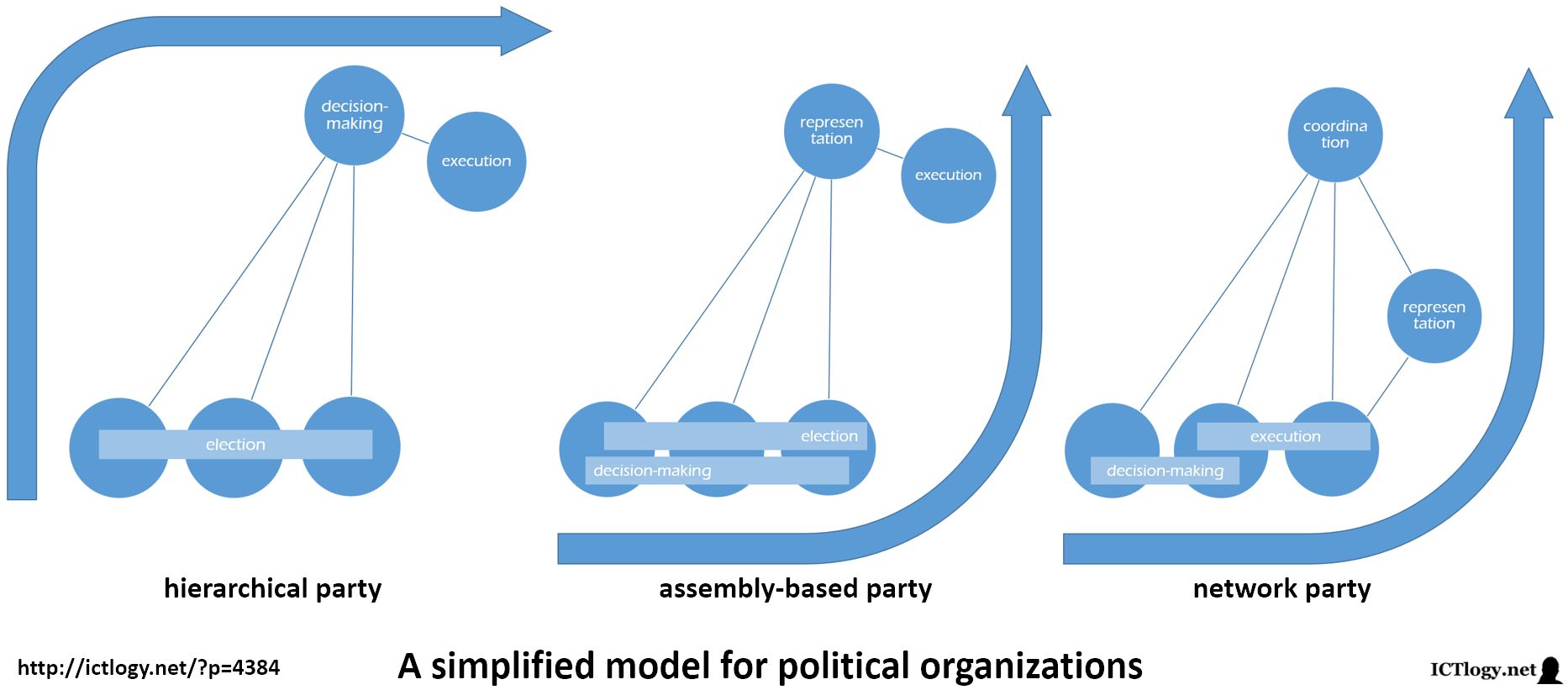It is difficult to put out a definition of the network party. Maybe — or mainly — because it is much a theoretical construct that does not exist purely in the real world. Any kind of human organization can be characterized, but it will rarely fit the theoretical model: the world is a world of grays.
New politics, technopolitics and political parties
The Spanish 15M Indignados Movement — and everything that came before it — brought new ways of organization which, later on, some of them, entered the political institutions. 2015 saw witnessed three important elections in Spain — municipalities, the Catalan Parliament, and the Spanish Parliament — to which some new and not-so-new parties concurred. A recurrent debate between new and traditional parties was whether these parties, respectively, were doing “new politics” or “old politics”.
One way to define “new politics” was that “new parties” were putting in the political agenda the quality of democracy, sometimes labelled as the “regeneration axis” (in addition to the social or right-left ideological axis). Little to be mentioned here. I personally believe that defending this new axis is a necessary but not sufficient condition or characteristic of new politics.
Another way to define “new politics” was that some political parties were assembly-based. That is, decisions are made at the grassroots level, in the party’s general assembly, and the representatives of the part translate them in the institutions.
In my opinion, this is not only not new politics, but totally misleading to what technopolitics is bringing to the political arena.
First of all, while unheard in most Western democracies, assemblies are anything but new. To say the least, they date from the late XIXth century. This is neither bad nor good: it is just not new.
Second, assemblies might by a part of new politics — or, better put, network parties — but the tool does not make the thing. Following, we will try to describe how three different organizations work: hierarchical parties, assembly-based parties and (despite the difficulty to come up with a proper definition) what a theoretical approach to network parties would look like. Please bear in mind what was said above: theoretical models of organizations do not aim at describing how specific organizations should be or work like, but to understand why the are or work the way they do. In a world full of greys.
Hierarchies
Let us propose a very simplified model where only three things occur: electing representatives, making decisions and executing them.
In a hierarchical party, most things happen in the upper layer of the organization: the lower layer elects their representatives (a secretary general, a secretariat, an executive committee, etc.) and, most of the times, remains outside of the general dynamics of the party.
The elected representatives, though, make all decisions and directly or indirectly execute them. Most of the times too — sad as it may sound — these elected representatives do not even inform the members and sympathisers of the party of the decisions made, and of course very rarely consult them on any issues at all.
At the end of the political cycle, the representatives are accountable for their successes and failures and can be replaced depending on their performance — usually measured in votes or seats, and not in the programme they put out and the actions they took (tough, of course, both of them had an impact that translated in votes, seats, laws passed, etc.).
Assembly-based parties
Assembly-based parties work almost opposite than hierarchical parties: the assembly meets, deliberates and makes a decision. Then, once the decision is made, the assembly elects some people that will carry on with the decision and put it into practice.
Oftentimes, these parties have to engage in conversations with other parties, translate the decision into an institution, or simply speak to the media. It is then usual that the same elected representatives emerging from the assembly also play the role of representing the assembly before third parties.
Note how the pair electing-deciding is inverted: if hierarchies elected people to decide what to do it and do it, assemblies decide what to do and elect the ones that will do it.
As we have already said, things in the real world are much more messy and much less clean. But, in simple lines, this is more or less how it theoretically works.
Network parties
Network parties also invert a pair of steps, but it is not electing of deciding, but executing: in network parties, executing comes first. How is that possible?
Levy, Himanen, Raymond or Benkler, among others, have explained with details the logics of free software and how they can be translated into other knowledge intensive projects. Like, for instance, politics.
In a gift economy, powered by meritocracy and led by do-ocracy people just can set the snowball rolling. If it catches, people will join and the idea, the project, will grow and become important. Otherwise, the idea will be tacitly abandoned and people will move onto other ideas and projects to join and contribute to.
In (pure) technopolitics, network parties emerge from people making decisions first and then executing them. If the projects grow and communities form, then comes the need for some coordination, for some “benevolent dictator” that may coordinate the efforts, make some punctual decisions. These coordinating person or body is elected by the participants on the project, either tactitly — based on her own merit — or explicitly, if there is a need to.
Sometimes the coordinating body will, as it happened with the assembly-based organizations, play the role of representing the collective. But sometimes it will not, as the collective will also have a collective identity and thus will represent itself without the need of intermediation from a specific body.
Following we can see the three (simplified) models for better comparison. It is worth noting how both assembly-based parties and network (or technopolitics-based) parties invert the relationships of power, bringing the decision-making to the bottom — and unlike traditional or hierarchical parties, which have decision-making at the top. But a crucial difference between assembly-based parties and network parties is where execution happens: in network parties, not only decision-making but also execution is distributed and takes place at the bottom. And this is what makes politics new: not only where decision-making takes place, but also where execution does.
As it has been said, these are “elements rarely found as pure substances”, that is, theoretical (and very much simplified) models whose aim is neither saying how things should work, nor how all parties can be distinctively and exhaustively categorized. On the contrary, we may find parties whose inner structure follows a different model depending on the stage, the level at which is is analysed, or even the time or specific task being developed. Thus, it is unlikely to find a party or an organization that perfectly fits the theoretical model, as it is likely to find many parties and organizations that embed in their organizational and operational design several bits of these models. Depending on which one prevails, or leads the culture of the organization, we will be able to generically label them one way or the other.
If you need to cite this article in a formal way (i.e. for bibliographical purposes) I dare suggest:
Peña-López, I. (2016) “Are assembly-based parties network parties?” In ICTlogy,
#148, January 2016. Barcelona: ICTlogy.
Retrieved month dd, yyyy from
https://ictlogy.net/review/?p=4384
Previous post: The networked educator — an approach from distributed leadership
Next post: Open Government: A simplified scheme
1 Comment to “Are assembly-based parties network parties?” »
 RSS feed for comments on this post.
TrackBack URI
RSS feed for comments on this post.
TrackBack URI






Pingback: Od demokratije ka slobodi – 5. deo - Klasna solidarnost